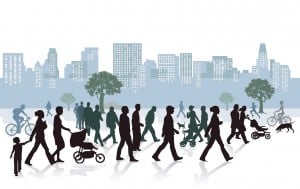Our cities are going to get bigger.
We shouldn't waste our time trying to stop this.
So this week I look at the projected increase in the number of households in Australia.
I have included two tables below.
Key points
- The forecast is that we will see the creation of an additional 1.56 million households (or 156,000 new households per annum) over the next decade.
- Over 85% of this growth – when you factor in the wider Sydney area and SEQld - will be in, or adjacent to, our eight major capital cities. See table 1.
- Narrowing this down a bit further, some 80% of the growth is expected to take place in four urban areas – Melbourne, the Sydney metropolis, SEQld and Perth.
- These four urban areas are expected to increase by 1.247 million households over the next decade. See table 2.
- If this happens the number of households in this combined area will increase by 20% from today’s total. That's one additional household for every five existing homes in the space of just ten years. At this rate these four urban areas will double in size within the next 40 years.
- Regional Australia is expected to increase but not by anywhere near as much.
When excluding Newcastle, Wollongong, Gold Coast, Sunshine Coast and Toowoomba from this count, the resultant 210,000 projected increase over the next decade equates to just a 11% lift in the existing regional Australian household count. Revisit table 1.
Table 1: Summary
| Location | Total households | Annual increase | % share of total increase | % increase in city size | |
| 2019 | 2029 | ||||
| Australia | 9,648,665 | 11,205,601 | 155,694 | 100% | 16% |
| Capitals | 6,335,403 | 7,533,768 | 119,837 | 78% | 19% |
| Regions | 3,313,262 | 3,671,833 | 35,857 | 22% | 11% |
| Capitals* | 7,563,377 | 8,908,223 | 134,485 | 86% | 18% |
| Regions** | 2,085,288 | 2,297,378 | 21,209 | 14% | 11% |
| Matusik + ABS. Medium series. Capitals* includes Sydney Metropolis + SE Qld. Regions ** excludes Sydney Metropolis + SE Qld. | |||||
Table 2: Capital Cities
| Location | Total households | Annual increase | % share of total increase | % increase in city size | |
| 2019 | 2029 | ||||
| Sydney | 1,903,729 | 2,255,868 | 35,214 | 23% | 18% |
| Melbourne | 1,876,876 | 2,312,668 | 43,579 | 28% | 23% |
| Brisbane | 902,042 | 1,083,512 | 18,147 | 12% | 20% |
| Perth | 789,870 | 920,902 | 13,103 | 8% | 17% |
| Adelaide | 546,839 | 595,357 | 4,852 | 3% | 9% |
| Canberra | 167,040 | 197,557 | 3,052 | 2% | 18% |
| Hobart | 97,986 | 109,568 | 1,158 | 1% | 12% |
| Darwin | 51,021 | 58,336 | 732 | 0% | 14% |
| Sydney metropolis* | 2,470,741 | 2,875,538 | 40,480 | 26% | 16% |
| SEQld** | 1,563,004 | 1,838,297 | 27,529 | 18% | 18% |
| Matusik + ABS. Medium series. Sydney metropolis* includes Newcastle + Wollongong. SEQld** includes Gold Coast, Sunshine Coast and west to Toowoomba. | |||||
Comments
Not surprisingly, talk has now turned to moving new overseas migrants to the regions and spending even more money on major transport infrastructure projects in our major capitals.
For mine this is a waste of money and time.
We will not be able to encourage people live where they don’t want to live; let alone enforce it.
The big-ticket transport projects that get approved really don’t solve much – apart from giving the pollies a tool to campaign with and a photo op at the ribbon cutting somewhere later down the line.
They are almost always delivered later and at far greater expense than originally forecast.
Plus, their economic benefit is dubious at best and more often than not they actually add to the problem rather than make things better.
Our cities are going to get bigger.
We shouldn't waste our time trying to stop this.
We should be making our cities better. And that must start with a plan.
It would be best if that plan was universal – well Australian wide at least – and frankly I think it is very simple.
The plan involves just three things:
- Getting people to travel less.
- Getting people to travel at different times.
- Getting people to travel in different directions.
That’s it.
This should be easy. 
The market is already supporting this strategy.
In fact across most spheres, business is actually pushing this agenda.
Politics, bureaucrats, regulations, vested interest groups and the 24-hour media cycle are – pardon the pun - the road blocks.
If we implement these three things, we can improve our cities and save many billions of dollars each year in wasted infrastructure spending and incidental costs caused by traffic congestion and unnecessary business expenses.
















